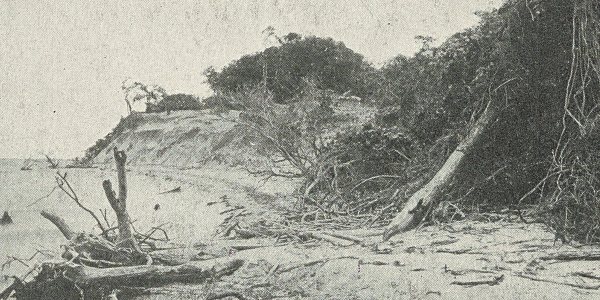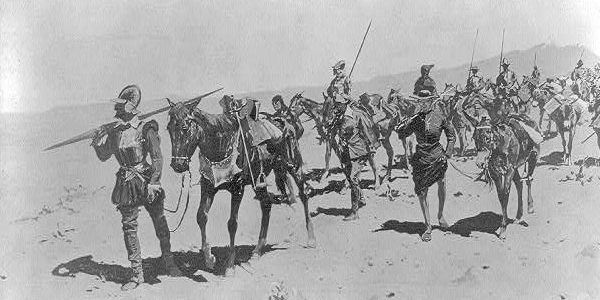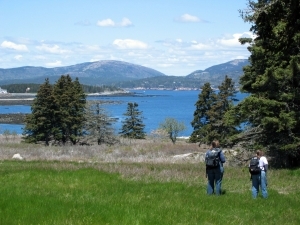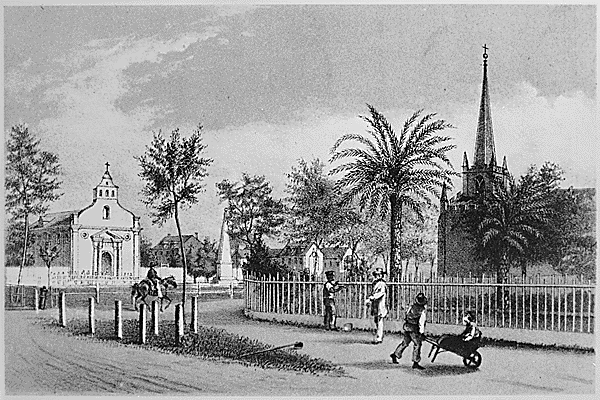Sponsor this page. Your banner or text ad can fill the space above.
Click here to Sponsor the page and how to reserve your ad.
-
Timeline
Detail - 1585
August 17, 1585 - Roanoke Island colony is founded by an expedition organized by Sir Walter Raleigh (Raleigh never visited North America himself) during his attempt to colonize the area of Virginia and North Carolina. The colony fails.
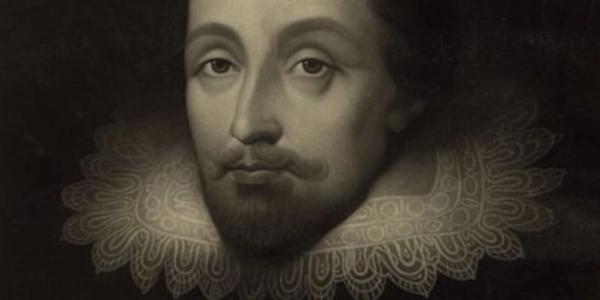
It had been twenty years since the Spanish had established their first permanent colony in North America at St. Augustine in 1565. All the English had to show for their colonial efforts were failures. Sir Walter Raleigh wanted to end that. Raleigh had been born in 1554 (some sources state 1552) to a prominent seafaring family from Devonshire; they had, at times, fallen into less favor and prosperity by the time of his birth.
Despite his parents status, he would become friends with Queen Elizabeth I, rising to political power in the English Renaissance. He had studied at Oriel College, at Oxford, although he did not graduate, fought for the Huguenots against the French, and traveled to the west to find the Northwest Passage to the Orient in 1578. By the time of his organization of the first English attempt at colonization at Roanoke, during the 1584 expedition to Virginia, he had been knighted. The Queen was in full support of his ventures.
In 1583, Sir Walter Raleigh had been part of a venture to retrace Cabot's voyage to Newfoundland, then south. It was commanded by his half-brother, Admiral Sir Humphrey Gilbert, with two hundred and sixty men and five ships. One of the ships had been commissioned and paid for by Raleigh himself, a two hundred ton ship called Ark Ralegh, which cost two thousand pounds. However, his ship, without him, never made the trip, the crew attacked by a contagious sickness. Down one ship, but not knowing why, Gilbert continued. Upon his arrival at Newfoundland, there were other nations present, but Gilbert planted England's flag there on auspices of Cabot's discovery ninety years before. However, his journey south was plagued with problems, and on his way back home, down to two ships, including the Golden Hinde of Plymouth fame, Sir Humphrey Gilbert, on the smaller ship Squirrel, was lost at sea.
This would not deter Sir Walter Raleigh from establishing another voyage for colonization. While he would mourn his half-brother's demise, he was even more determined to colonize the New World and challenge Spain's lead. This time, however, he would command his expedition to head further south. Raleigh would not be aboard; he never saw the New World on his own. He had been forbidden to accompany the mission by Queen Elizabeth I herself. She did, however, bless the venture, and had given him a charter on March 25, 1584, that was broader in scope than that of Admiral Sir Humphrey Gilbert.
Sir Raleigh's Charter (Portion) - March 25, 1584
"To all people to whom these presents shal come, greeting. Know ye that of our
especial grace, certain science, and meere motion, we have given and graunted, and
by these presents for us, our heires and successors, doe give and graunt, to our trusty
and welbeloved servant Walter Ralegh Esquire, and to his heires and assignes for
ever, free liberty and license from time to time, and at all times for ever hereafter, to
discover, search, finde out, and view such remote, heathen and barbarous lands, countries and territories, not actually possessed by any Christian prince, nor inhabited by
Christian people, as to him, his heires and assignes, and to every or any of them shal
seeme good; and the same to have, holde, occupy & enjoy, to him, his heires and assignes for ever; with all prerogatives, commodities, jurisdictios, royalties, privileges,
franchises and preeminences, thereto or thereabouts both by sea and land, whatsoever we by our letters patents may graunt, and as we or our noble progenitors have
heretofore graunted, to any person or persons, bodies politic or corporate; and the saide Walter Ralegh, his heires and assignes, and all such as from time to time, by licence
of us, our heires and successors, shal goe or travaile thither to inhabite or remaine,
there to builde and fortifie, at the discretion of the saide Walter Ralegh, his heires &
assignes, the statutes or act of Parliament made against fugitives, or against such as
shal depart, remaine or continue out of our Realme of England without licence, or any
statute, act, law, or any ordinance whatsoever to the contrary in any wise notwithstanding."
Raleigh would have a fleet of two vessels for this 1584 voyage, with the mission to explore not colonize. It was captained by Philip Amadas and Arther Barlow. They sailed during the last week of April and arrived, sighting land, during the first week of July. They had reached Virginia with the lure of finding gold. They encounted natives two days after landing. It was a cordial meeting with exchange of goods, which continued in the days ahead. The English were escorted into the interior of the island. Later, they would travel twenty miles to the island the natives called Roanoak. It was occupied by nine houses. The 1584 expedition would return to England in the middle of September. Two natives accompanied them, Manteo and Wanchese.

"To all people to whom these presents shal come, greeting. Know ye that of our especial grace, certain science, and meere motion, we have given and graunted, and by these presents for us, our heires and successors, doe give and graunt, to our trusty and welbeloved servant Walter Ralegh Esquire, and to his heires and assignes for ever, free liberty and license from time to time, and at all times for ever hereafter, to discover, search, finde out, and view such remote, heathen and barbarous lands, countries and territories, not actually possessed by any Christian prince, nor inhabited by Christian people, as to him, his heires and assignes, and to every or any of them shal seeme good; and the same to have, holde, occupy & enjoy, to him, his heires and assignes for ever; with all prerogatives, commodities, jurisdictios, royalties, privileges, franchises and preeminences, thereto or thereabouts both by sea and land, whatsoever we by our letters patents may graunt, and as we or our noble progenitors have heretofore graunted, to any person or persons, bodies politic or corporate; and the saide Walter Ralegh, his heires and assignes, and all such as from time to time, by licence of us, our heires and successors, shal goe or travaile thither to inhabite or remaine, there to builde and fortifie, at the discretion of the saide Walter Ralegh, his heires & assignes, the statutes or act of Parliament made against fugitives, or against such as shal depart, remaine or continue out of our Realme of England without licence, or any statute, act, law, or any ordinance whatsoever to the contrary in any wise notwithstanding."

First Attempt to Colonize Roanoke
The praise from the experience by Captains Amadas and Barlow made acquiring colonists for the 1585 journey easy. Seven ships would sail from Plymouth on April 9, 1585, with one hundred and eight householders. They were induced by Raliegh's promise of five hundred acres to a man. Prominent names were aboard; Thomas Cavendish (later on Drake's world navigation), plus Thomas Heriot, a noted mathematician and philosopher.
In command of the colonization project was Sir Richard Grenville. Sailing to the New World went well, through the West Indies to Puerto Rico. They arrived at the island of Wokoken, off the coast of North Carolina in June. Manteo and Wanchese were then sent ahead to alert their chiefs of the coming arrival. The chiefs were once again welcoming. Captain Ralph Lane would serve as governor of the colony; Captain Philip Amadas would be his lieutenant-governor. They arrived at the chosen site on August 17, 1585.
Grenville remained with his ships until the end of August, then sailed back to England. However, Sir Richard Grenville had been onerous during his one excursion to camp. For the cost of one silver cup, likely stolen by a native, he burned a native village to the ground. This changed the tenor of the natives immediately into suspicion and hostility. The colony would not have a firm foundation. Despite the building of several structures and planting of fields, there was an unease in the colony due to Grenville's action.
Governor Lane was still in pursuit of pearls and gold, and taking a small force with little supplies, he went up the Chawanook River for one hundred and sixty miles, facing native hostility at many turns. Before they returned to Roanoke, they ate their dogs. Native Chief Wingina had a force of eighteen hundred men when he attacked the party, but the English had guns. The Chief was killed, but now the colonists no longer had the native's assistance.
There had been a promise by Grenville that he would return by Easter with supplies; he did not. Who came? Sir Francis Drake after sacking Cartegena, Santo Domingo, and St. Augustine. He supplied the colonists with food and ammunition, plus two ships for use. They were destroyed in a storm soon after.
The colonists had, by that time, enough. The demands to return home with Drake were agreed to by Governor Lane. They sailed for England on June 19, 1586. They arrived on July 27, 1586. The first attempt to colonize Roanoke by the English ended in failure. Sir Richard Grenville arrived not long after with the promised supplies, but there was no white man there, nor many Indians. He left fifteen men with supplies to hold the settlement. By the next expedition, those men had perished.
Image above: Sir Walter Raleigh, 1902, Unknown Author. Courtesy Library of Congress. Below: Roanoke Island, where Raleigh's colonists would have landed in 1585, 1908, Unknown Author. Courtesy Library of Congress. Source info: "Sir Walter Raleigh," poetryfoundation.org; "Sir Walter Raleigh," 1909, Frederick A. Ober; "Sir Walter Ralegh, A Biography" 2008, William Stebbing, Gutenberg Project; Library of Congress; Wikipedia.
